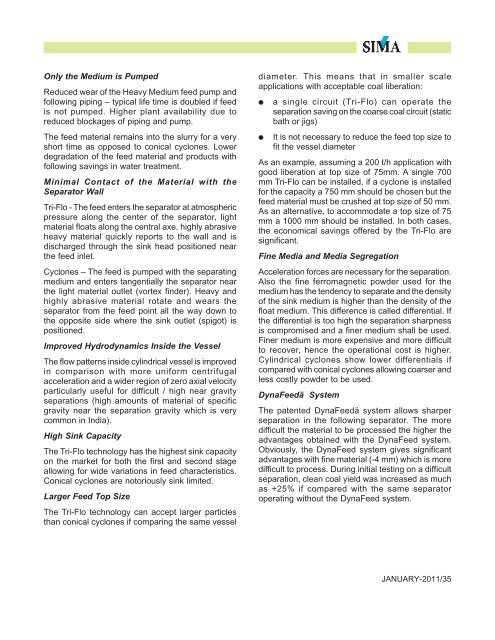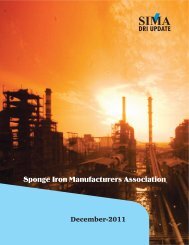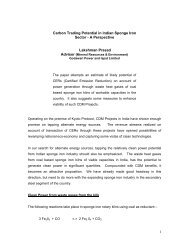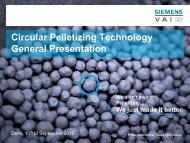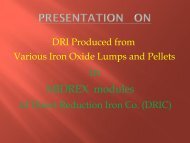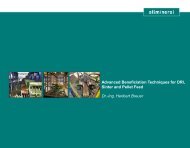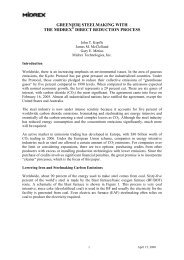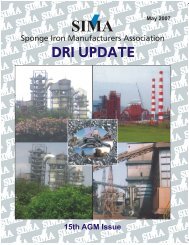sponge iron industry –past-present-future - SIMA
sponge iron industry –past-present-future - SIMA
sponge iron industry –past-present-future - SIMA
Create successful ePaper yourself
Turn your PDF publications into a flip-book with our unique Google optimized e-Paper software.
Only the Medium is Pumped<br />
Reduced wear of the Heavy Medium feed pump and<br />
following piping – typical life time is doubled if feed<br />
is not pumped. Higher plant availability due to<br />
reduced blockages of piping and pump.<br />
The feed material remains into the slurry for a very<br />
short time as opposed to conical cyclones. Lower<br />
degradation of the feed material and products with<br />
following savings in water treatment.<br />
Minimal Contact of the Material with the<br />
Separator Wall<br />
Tri-Flo - The feed enters the separator at atmospheric<br />
pressure along the center of the separator, light<br />
material floats along the central axe, highly abrasive<br />
heavy material quickly reports to the wall and is<br />
discharged through the sink head positioned near<br />
the feed inlet.<br />
Cyclones – The feed is pumped with the separating<br />
medium and enters tangentially the separator near<br />
the light material outlet (vortex finder). Heavy and<br />
highly abrasive material rotate and wears the<br />
separator from the feed point all the way down to<br />
the opposite side where the sink outlet (spigot) is<br />
positioned.<br />
Improved Hydrodynamics Inside the Vessel<br />
The flow patterns inside cylindrical vessel is improved<br />
in comparison with more uniform centrifugal<br />
acceleration and a wider region of zero axial velocity<br />
particularly useful for difficult / high near gravity<br />
separations (high amounts of material of specific<br />
gravity near the separation gravity which is very<br />
common in India).<br />
High Sink Capacity<br />
The Tri-Flo technology has the highest sink capacity<br />
on the market for both the first and second stage<br />
allowing for wide variations in feed characteristics.<br />
Conical cyclones are notoriously sink limited.<br />
Larger Feed Top Size<br />
The Tri-Flo technology can accept larger particles<br />
than conical cyclones if comparing the same vessel<br />
diameter. This means that in smaller scale<br />
applications with acceptable coal liberation:<br />
l a single circuit (Tri-Flo) can operate the<br />
separation saving on the coarse coal circuit (static<br />
bath or jigs)<br />
l It is not necessary to reduce the feed top size to<br />
fit the vessel diameter<br />
As an example, assuming a 200 t/h application with<br />
good liberation at top size of 75mm. A single 700<br />
mm Tri-Flo can be installed, if a cyclone is installed<br />
for the capacity a 750 mm should be chosen but the<br />
feed material must be crushed at top size of 50 mm.<br />
As an alternative, to accommodate a top size of 75<br />
mm a 1000 mm should be installed. In both cases,<br />
the economical savings offered by the Tri-Flo are<br />
significant.<br />
Fine Media and Media Segregation<br />
Acceleration forces are necessary for the separation.<br />
Also the fine ferromagnetic powder used for the<br />
medium has the tendency to separate and the density<br />
of the sink medium is higher than the density of the<br />
float medium. This difference is called differential. If<br />
the differential is too high the separation sharpness<br />
is compromised and a finer medium shall be used.<br />
Finer medium is more expensive and more difficult<br />
to recover, hence the operational cost is higher.<br />
Cylindrical cyclones show lower differentials if<br />
compared with conical cyclones allowing coarser and<br />
less costly powder to be used.<br />
DynaFeedä System<br />
The patented DynaFeedä system allows sharper<br />
separation in the following separator. The more<br />
difficult the material to be processed the higher the<br />
advantages obtained with the DynaFeed system.<br />
Obviously, the DynaFeed system gives significant<br />
advantages with fine material (-4 mm) which is more<br />
difficult to process. During initial testing on a difficult<br />
separation, clean coal yield was increased as much<br />
as +25% if compared with the same separator<br />
operating without the DynaFeed system.<br />
JANUARY-2011/35


